window Lancia Thesis 2007 Owner handbook (in English)
[x] Cancel search | Manufacturer: LANCIA, Model Year: 2007, Model line: Thesis, Model: Lancia Thesis 2007Pages: 386, PDF Size: 8.69 MB
Page 270 of 386
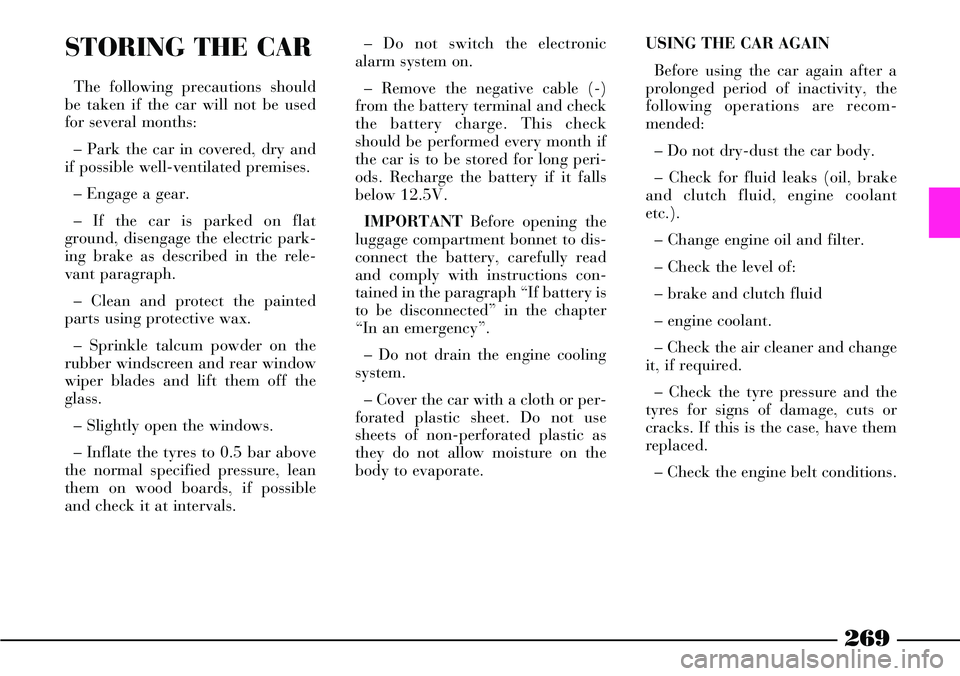
269
USING THE CAR AGAIN
Before using the car again after a
prolonged period of inactivity, the
following operations are recom-
mended:
– Do not dry-dust the car body.
– Check for fluid leaks (oil, brake
and clutch fluid, engine coolant
etc.).
– Change engine oil and filter.
– Check the level of:
– brake and clutch fluid
– engine coolant.
– Check the air cleaner and change
it, if required.
– Check the tyre pressure and the
tyres for signs of damage, cuts or
cracks. If this is the case, have them
replaced.
– Check the engine belt conditions.STORING THE CAR
The following precautions should
be taken if the car will not be used
for several months:
– Park the car in covered, dry and
if possible well-ventilated premises.
– Engage a gear.
– If the car is parked on flat
ground, disengage the electric park-
ing brake as described in the rele-
vant paragraph.
– Clean and protect the painted
parts using protective wax.
– Sprinkle talcum powder on the
rubber windscreen and rear window
wiper blades and lift them off the
glass.
– Slightly open the windows.
– Inflate the tyres to 0.5 bar above
the normal specified pressure, lean
them on wood boards, if possible
and check it at intervals.– Do not switch the electronic
alarm system on.
– Remove the negative cable (-)
from the battery terminal and check
the battery charge. This check
should be performed every month if
the car is to be stored for long peri-
ods. Recharge the battery if it falls
below 12.5V.
IMPORTANT Before opening the
luggage compartment bonnet to dis-
connect the battery, carefully read
and comply with instructions con-
tained in the paragraph “If battery is
to be disconnected” in the chapter
“In an emergency”.
– Do not drain the engine cooling
system.
– Cover the car with a cloth or per-
forated plastic sheet. Do not use
sheets of non-perforated plastic as
they do not allow moisture on the
body to evaporate.
Page 300 of 386

299
Devices and utilities
Engine control system point interface
Brake system point interface
Headlight washers
Heated rear window
Automatic gearbox starter
NIM
Passenger position point
Steering lock point
Brake Assistant point
(*) As an alternative for certain versions/markets
Braking system point (NFR 1)
Braking system point (NFR 2)
Infotelematic point
Yaw Lateral point
(*) As an alternative for certain versions/markets
Keyless System point
Driver door point
Driver door point (power supply)
Passenger door point
Fuse
22
29
15
17
17
6
14
22
19 (*)
13 (*)
19
1
6
6
19 (*)
13 (*)
19
22
11
8
11
23
Ampere
7.5
7.5
20
30
30
10
10
10
10
10
7.5
40
40
10
10
10
7.5
10
20
20
20
7.5
Location
fig. 75
fig. 73
fig. 75
fig. 73
fig. 75
fig. 73
fig. 78
fig. 78
fig. 78
fig. 73
fig. 73
fig. 75
fig. 75
fig. 73
fig. 78
fig. 73
fig. 73
fig. 78
fig. 78
fig. 73
fig. 78
fig. 73
Page 302 of 386
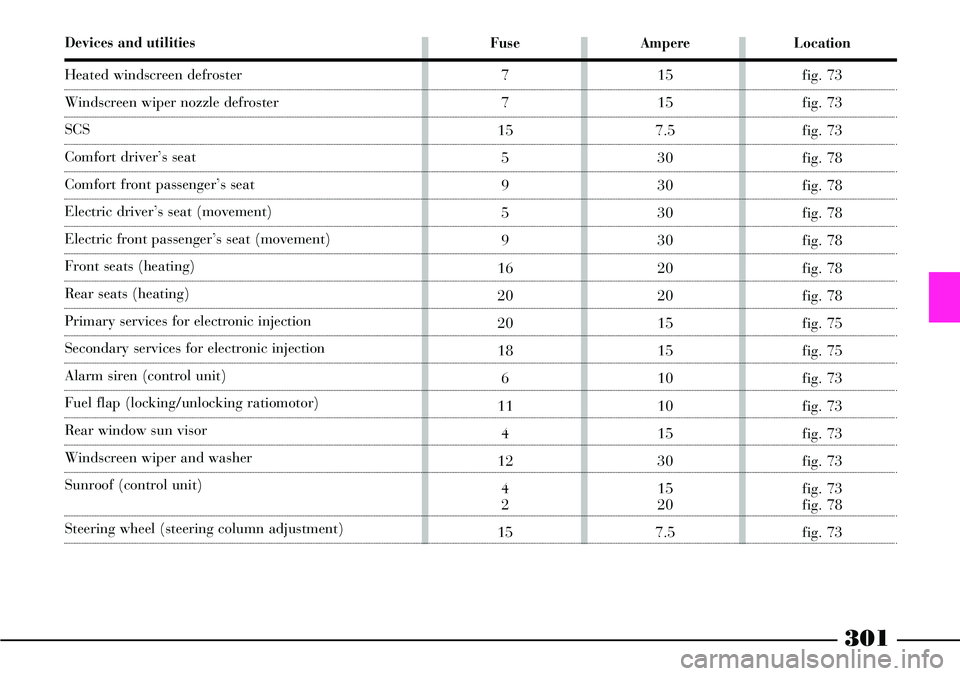
301
Devices and utilities
Heated windscreen defroster
Windscreen wiper nozzle defroster
SCS
Comfort driver’s seat
Comfort front passenger’s seat
Electric driver’s seat (movement)
Electric front passenger’s seat (movement)
Front seats (heating)
Rear seats (heating)
Primary services for electronic injection
Secondary services for electronic injection
Alarm siren (control unit)
Fuel flap (locking/unlocking ratiomotor)
Rear window sun visor
Windscreen wiper and washer
Sunroof (control unit)
Steering wheel (steering column adjustment)
Ampere
15
15
7.5
30
30
30
30
20
20
15
15
10
10
15
30
15
20
7.5
Location
fig. 73
fig. 73
fig. 73
fig. 78
fig. 78
fig. 78
fig. 78
fig. 78
fig. 78
fig. 75
fig. 75
fig. 73
fig. 73
fig. 73
fig. 73
fig. 73
fig. 78
fig. 73
Fuse
7
7
15
5
9
5
9
16
20
20
18
6
11
4
12
4
2
15
Page 309 of 386

308
– In pile-ups on the motorway,
particularly when the visibility is
bad, there is a high risk of other
vehicles running into those already
stopped. Get out of the car immedi-
ately and take refuge behind the
guard rail.
– If the doors are blocked, do not
attempt to smash the windscreen to
get out of the car. It is made of lay-
ered glass and is very hard. Side and
rear window are much more easily
broken.
– Remove the ignition keys from
the vehicles involved.
– If you can smell petrol or other
chemicals, do not smoke and make
sure all cigarettes are extinguished.
– Use a fire extinguisher, blanket,
sand or earth to put out fires no
matter how small they are. Never
use water.
– If it is not necessary to use the car
light system, disconnect the negative
terminal (–) from the battery pole.IF ANYONE IS INJURED
Never leave the injured person alone.
The obligation to provide assistance
exists even for those not directly in-
volved in the accident
– Do not congregate around the in-
jured person
– Reassure the injured person that
help is on its way and will arrive soon.
Stay close by to calm him/her down
in case of panic
– Unfasten or cut seat belts holding
injured parties
– Do not give an injured person any-
thing to drink.
– Do not move an injured person un-
less the following situations arise
– Pull the injured person from the
car only if it risks catching fire, it is
sinking in water or is likely to fall over
a cliff or similar. Do not pull his/her
arms or legs, do not bend the head
and, as far as possible, keep the body
horizontal.IF AN ACCIDENT
OCCURS
– It is important to keep calm.
– If you are not directly involved in
the accident, stop at least ten metres
away from the accident.
– If you are on a motorway do not
obstruct the emergency lane with
your car.
– Turn off the engine and turn on
the hazard lights.
– At night, illuminate the scene of
the accident with your headlights.
– Act carefully, you must not risk
being run over.
– Mark the accident by putting the
red triangle at the regulatory dis-
tance from the car where it can be
clearly seen.
– Call for rescue making the infor-
mation you give as accurate as you
can. On the motorway use the spe-
cial column-mounted emergency
phones.
Page 313 of 386

312
SERVICE SCHEDULE
20 40 60 80 100 120 140 160 180 thousands of kilometres
ççççç çççç
ççççç çççç
ççççç çççç
çç çç
ççççç çççç
ççççç çççç
çç
çç çç
ççççç çççç
çç
çç çç
ççççç çççç
ççççç ççççCheck tyre conditions and wear; adjust pressure, if required
Check primary and secondary battery charge status
Check wear of windscreen/rear window blades
Check rear disc brake pad wear
Inspect conditions of: underbody protection and outside
bodywork, piping (exhaust - fuel lines - brake lines), rubber parts
(boots, sleeves, bushings, etc.), brake and fuel line hoses
Check for bonnet and boot lock cleanness, lever cleanness
and lubrication
Sight check for conditions of Poly-V accessory drive belt
Check diesel engine smokiness in exhaust
Replace fuel filter (JTD versions)
Check fuel evaporation system operation
Replace air cleaner cartridge (petrol versions)
Replace air cleaner cartridge (JTD versions)
Check and top up fluids (engine coolant, brakes,
hydraulic clutch, power steering, windscreen washer, battery, etc.)
Page 315 of 386
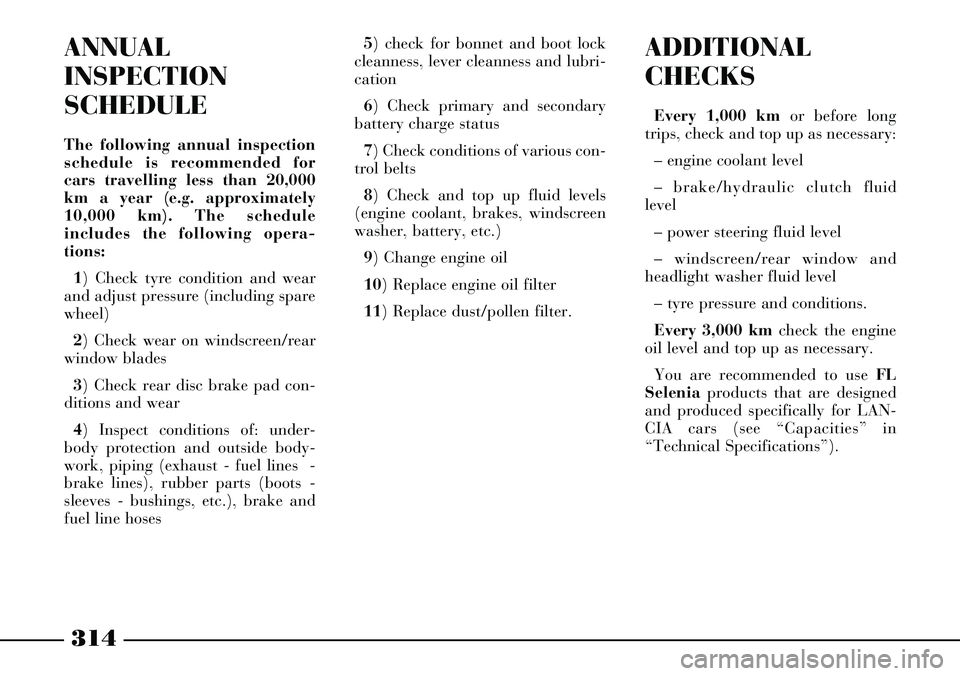
314
ADDITIONAL
CHECKS
Every 1,000 kmor before long
trips, check and top up as necessary:
– engine coolant level
– brake/hydraulic clutchfluid
level
– power steering fluid level
– windscreen/rear window and
headlight washer fluid level
– tyre pressure and conditions.
Every 3,000 kmcheck the engine
oil level and top up as necessary.
You are recommended to use FL
Seleniaproducts that are designed
and produced specifically for LAN-
CIA cars (see “Capacities” in
“Technical Specifications”).
ANNUAL
INSPECTION
SCHEDULE
The following annual inspection
schedule is recommended for
cars travelling less than 20,000
km a year (e.g. approximately
10,000 km). The schedule
includes the following opera-
tions:
1) Check tyre condition and wear
and adjust pressure (including spare
wheel)
2) Check wear on windscreen/rear
window blades
3) Check rear disc brake pad con-
ditions and wear
4) Inspect conditions of: under-
body protection and outside body-
work, piping (exhaust - fuel lines -
brake lines), rubber parts (boots -
sleeves - bushings, etc.), brake and
fuel line hoses5) check for bonnet and boot lock
cleanness, lever cleanness and lubri-
cation
6) Check primary and secondary
battery charge status
7) Check conditions of various con-
trol belts
8) Check and top up fluid levels
(engine coolant, brakes, windscreen
washer, battery, etc.)
9) Change engine oil
10) Replace engine oil filter
11) Replace dust/pollen filter.
Page 318 of 386
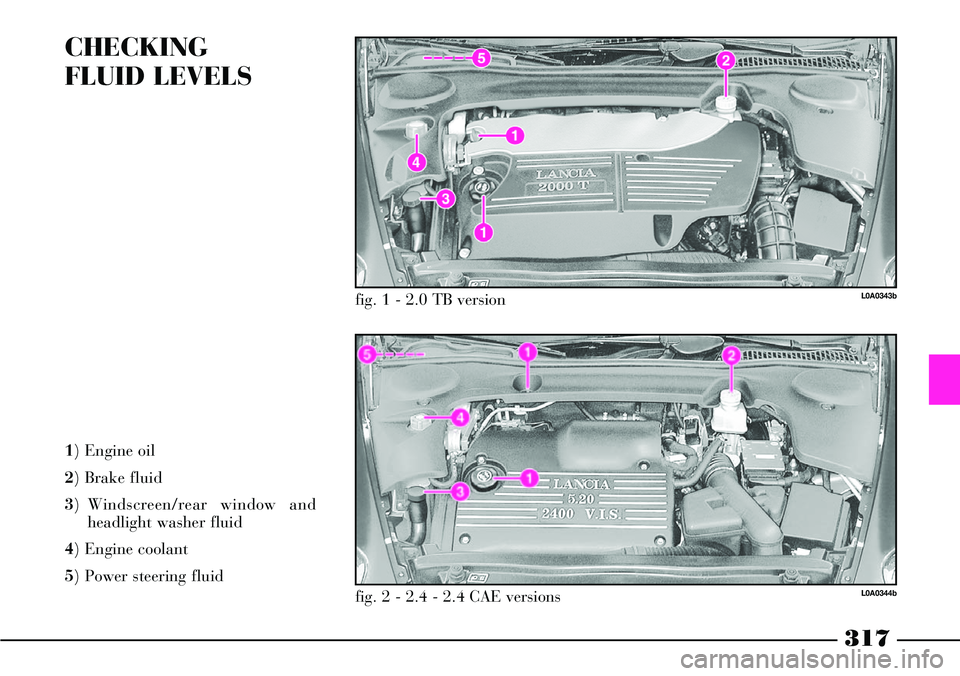
317
CHECKING
FLUID LEVELS
1) Engine oil
2) Brake fluid
3) Windscreen/rear window and
headlight washer fluid
4) Engine coolant
5) Power steering fluid
L0A0343b
L0A0344b
fig. 1 - 2.0 TB version
fig. 2 - 2.4 - 2.4 CAE versions
Page 319 of 386
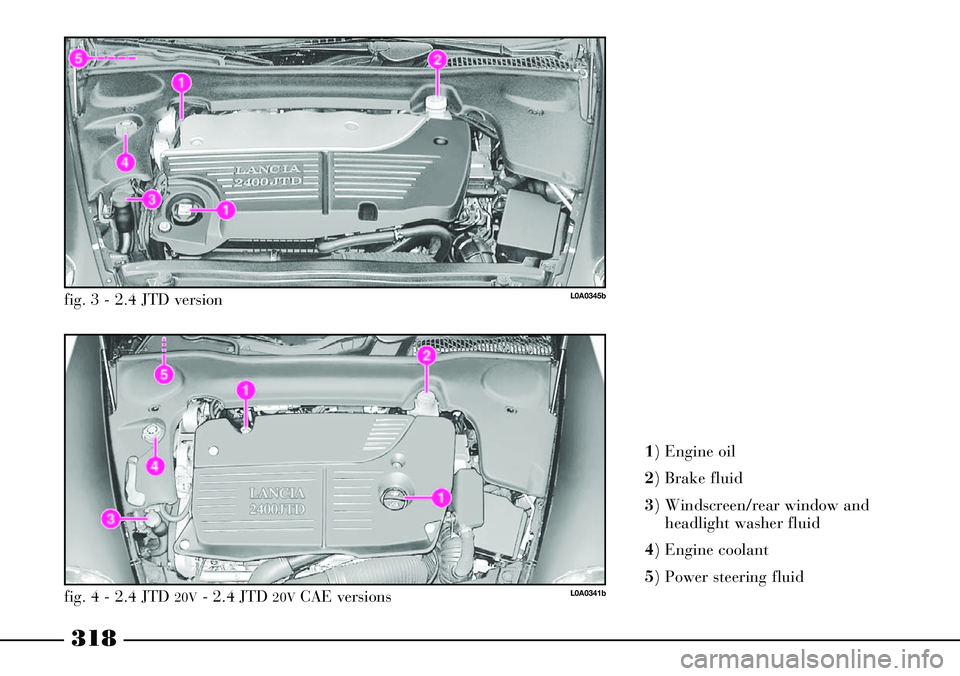
318
1) Engine oil
2) Brake fluid
3) Windscreen/rear window and
headlight washer fluid
4) Engine coolant
5) Power steering fluid
L0A0345b
L0A0341b
fig. 3 - 2.4 JTD version
fig. 4 - 2.4 JTD
20V- 2.4 JTD 20VCAE versions
Page 320 of 386
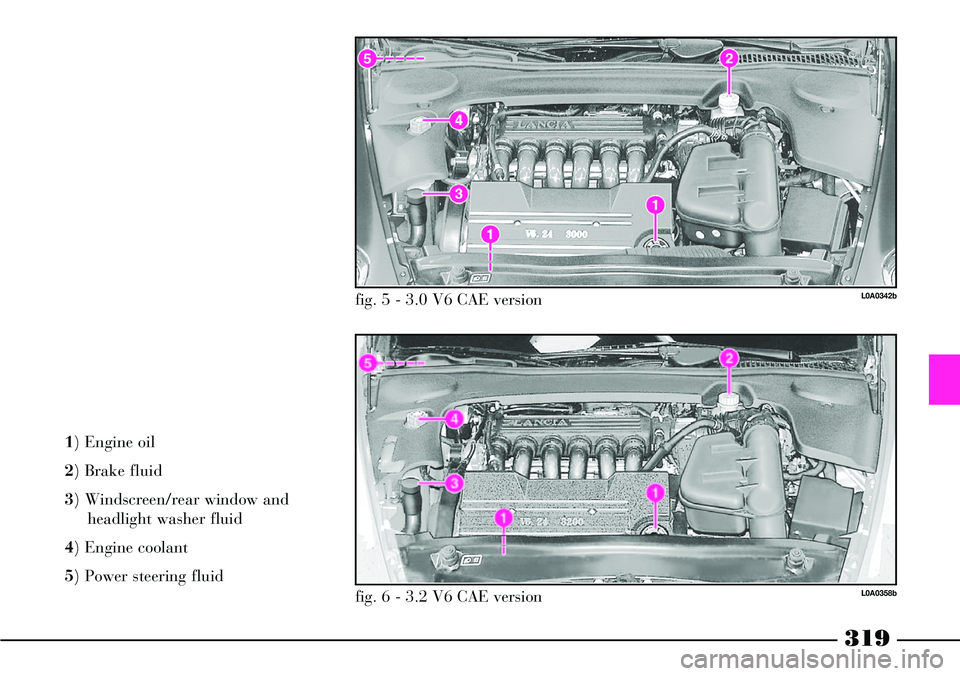
319
1) Engine oil
2) Brake fluid
3) Windscreen/rear window and
headlight washer fluid
4) Engine coolant
5) Power steering fluid
L0A0342b
L0A0358b
fig. 5 - 3.0 V6 CAE version
fig. 6 - 3.2 V6 CAE version
Page 325 of 386

324
WINDSCREEN/REAR
WINDOW/HEADLIGHT
WASHER FLUID (fig. 17)
To top up, remove cap Aand filler
B.
Pour in a mixture of water and
TUTELA PROFESSIONAL SC 35
fluid in the following concentrations:
– 30% of the above specified fluid
and 70% water in summer
– 50% of the above specified fluid
and 50% water in winter
– if the temperature falls below –20
°C use TUTELA PROFESSIONAL
SC 35undiluted.Certain commercial
additives for windscreen
washers are inflammable.
The engine compartment con-
tains hot components which may
set it on fire.
Do not travel with the
windscreen washer reser-
voir empty. The wind-
screen washer is fundamental for
improving visibility.
fig. 17
L0A0295b
To prevent damages to
the pump motor, do not
use the windscreen/rear
window/headlight washers when
the reservoir is empty.
The symbol πon the
container indicates syn-
thetic brake fluid, distin-
guishing it from the mineral kind.
Using mineral fluids irreversibly
damages the special braking sys-
tem rubber seals.
Brake fluid is poisonous
and highly corrosive. In
the event of accidental
contact, wash the parts involved
immediately with neutral soap and
water, then rinse thoroughly. Call
the doctor immediately if the fluid
is swallowed.